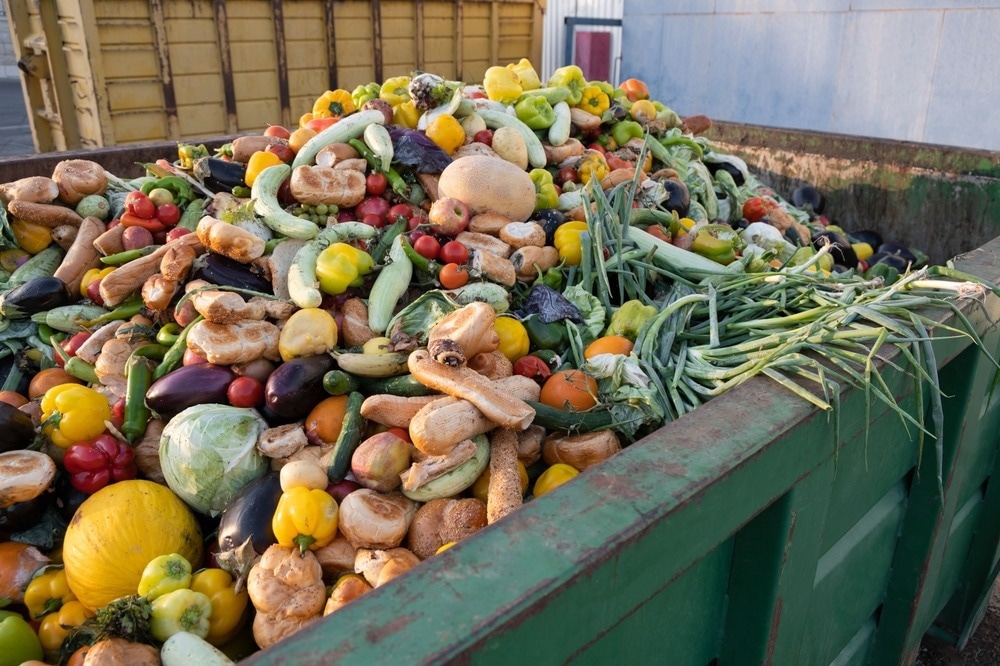Scientists have developed a new building material using a surprising raw material: food waste. This new material could significantly benefit the construction industry in terms of sustainability and reducing the impact of greenhouse gases in the sector.

Image Credit: ArieStudio/Shutterstock.com
This environmentally friendly material has been developed by scientists from Fabula Inc., a startup and commercial offshoot of the University of Tokyo.
Improving the Green Credentials of the Construction Sector
Construction is a key global industrial activity that consumes vast amounts of raw materials annually. As well as using natural materials which cannot easily be renewed, the construction of new buildings and infrastructure is responsible for a significant proportion of global greenhouse emissions.
Concrete production alone contributes around 8% of all annual carbon emissions worldwide. Most of the carbon emissions from concrete production are due to the production of clinker.
As well as the manufacture of raw materials, carbon emissions in the construction industry come from other sources, such as diesel-powered plant equipment, transportation, and quarrying activities.
Due to the environmental impact of the construction sector and the growing worldwide demand for raw building materials, the industry is constantly exploring new, more sustainable materials and processes. If the sector is to achieve its net zero aims, it will need to rapidly curtail its emissions over the next decade.
However, green alternatives to concrete and other traditional building materials must be able to meet strict property requirements such as tensile strength, flexural strength, and toughness to avoid potential critical safety issues.
Worldwide Food Waste: A Key Sustainability Issue
Another key global sustainability issue is food waste. Much like concrete production, food waste accounts for around 8% of total global greenhouse gas emissions. Most food waste ends up in landfills, where it breaks down and produces methane, which is a potent greenhouse gas. Methane is worse than CO2.
In the US alone, the greenhouse gas emissions from food waste are equivalent to over forty coal-fired power stations. Additionally, vast tracts of land are required to dispose of food waste, and handling this environmental issue uses enough energy and water to power over 50 million homes.
Over-production of food leads to vast amounts of waste, not just of the food itself but also of packaging and materials used to harvest it in the first place. Furthermore, transportation emissions arguably go to waste as the end result is wasted food that could otherwise have been sold and used by families to feed themselves.
Aside from food products, food waste also includes peel and skins, which are edible, and inedible stalks, shoots, grounds, and leaves. Hundreds of billions of dollars of wasted food are generated per year worldwide.
Food waste is a key environmental, economic, social, and political challenge that is a damning indicator of current systems of food management and environmental stewardship. More circular and sustainable systems of food chain management are desperately needed to curtail the growing global impact of food waste.
The Solution: Construct Buildings from Food Waste.
Millions of tons of food waste are generated worldwide, begging the question: What can be done about this key environmental issue? One answer may be staring the construction industry in the face: use it as a building material, reduce food waste, and improve sustainability in construction.
Scientists at Fabula have developed a new material with four times the bending strength (which is closely related to flexural strength) of concrete, making it a suitable material for construction.
A process used to produce construction materials from wood pulp was used in the research. The method uses heat pressing. However, instead of wood, the process compacts food waste such as coffee grounds, citrus peels, and cabbage stalks.
Once the scraps are compressed, they are freeze-dried and powdered, and mixed with water and seasonings. Once prepared, a high-temperature press is used in the final manufacturing step to produce the desired product, which is then tested.
However, not all types of food waste are appropriate for use as a construction material as they cannot meet the bending strength requirements. For instance, pumpkin waste is not adequate and has to be modified with Chinese cabbage leaves.
The material possesses noteworthy physical properties: it can reach four times the bending strength of concrete, and a 5mm plate produced from food waste can withstand 30kg in weight applied to it.
Notably, no adhesives are used in the process, meaning that the material is highly sustainable, environmentally friendly, and even edible. Furthermore, aside from robust construction materials, the product can be used to manufacture sustainable crockery, tools, and furniture.
In Summary
Food waste is a global societal, environmental, and economic burden. With the growing demand for food worldwide, there is an urgent need to develop circular methods of food waste management which reduces carbon emissions and energy, water, and land use.
By utilizing waste scraps of food as a robust construction material, whilst maintaining its edibility and using no adhesives, the process developed by scientists at Fabula facilitates the development of creative solutions for many industrial sectors from only one technology.
More from AZoBuild: Harnessing Renewable Energy in Construction
Further Reading and More Information
Institute of Industrial Science, The University of Tokyo (2021) Food Scraps Get a Bold New Life [online] iis.u-tokyo.ac.jp. Available at:
https://www.iis.u-tokyo.ac.jp/en/news/3567/
Lab Manager (2021) Scientists Turn Food Waste into Construction Materials [online] labmanager.com. Available at:
https://www.labmanager.com/scientists-turn-food-waste-into-construction-materials-25942
Material District (2022) An Edible Building Material Made of Food Waste [online] materialdistrict.com. Available at:
https://materialdistrict.com/article/an-edible-building-material-made-of-food-waste
Disclaimer: The views expressed here are those of the author expressed in their private capacity and do not necessarily represent the views of AZoM.com Limited T/A AZoNetwork the owner and operator of this website. This disclaimer forms part of the Terms and conditions of use of this website.